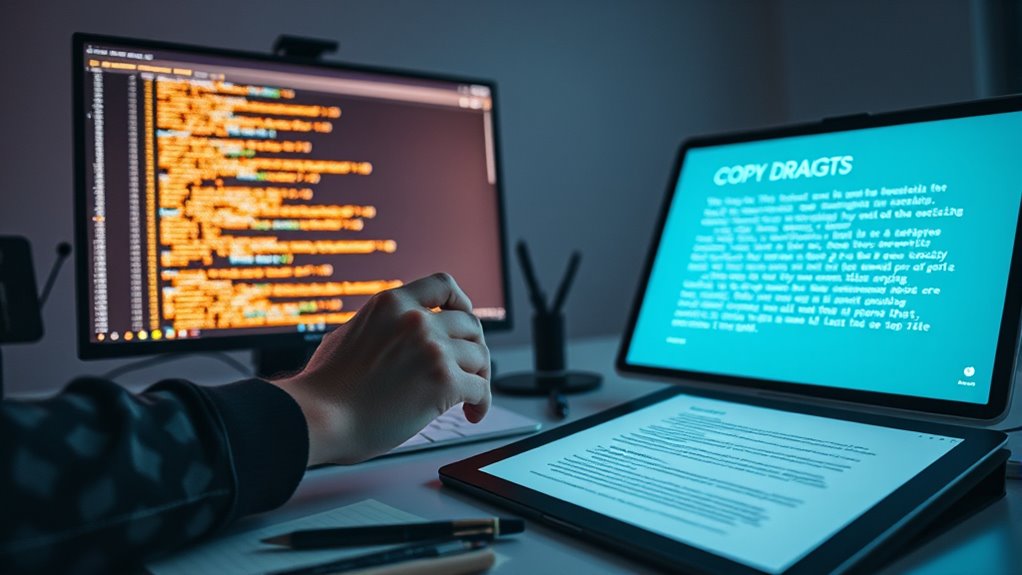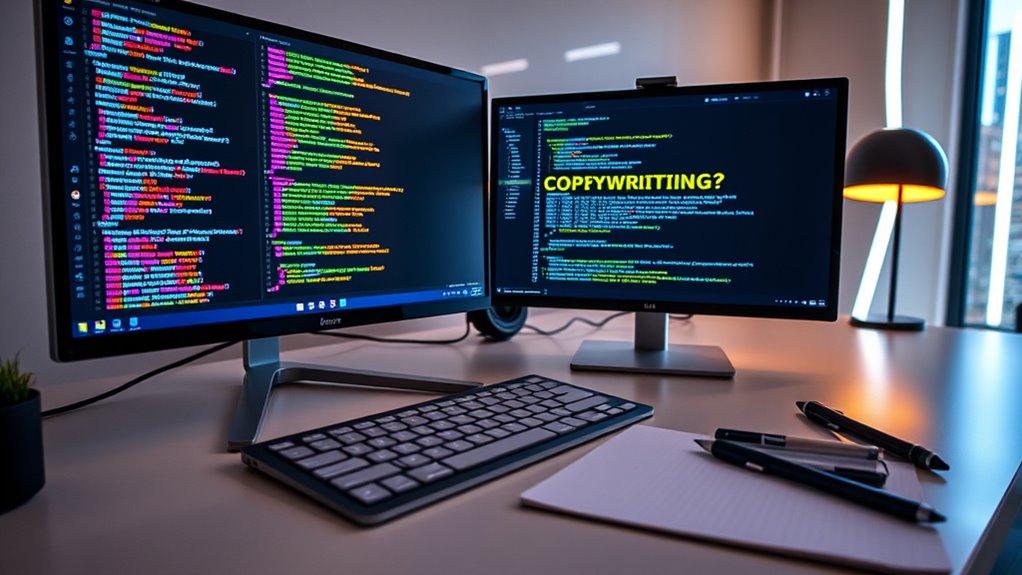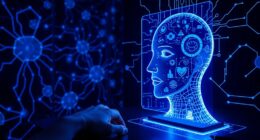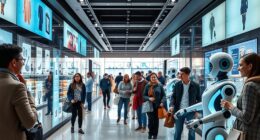Yes, LLMs are automating many aspects of creative work like coding and copywriting. They help generate code snippets, debug programs, and create marketing content quickly and efficiently. While they boost productivity and support multiple languages, they still need human oversight for accuracy, originality, and emotional depth. If you keep exploring, you’ll discover how these tools are transforming creative industries and what challenges they bring.
Key Takeaways
- LLMs automate routine coding tasks, code generation, debugging, and translation, boosting software development productivity.
- They assist in content creation by generating drafts, ideas, and tailored marketing copy across multiple formats and languages.
- Human oversight remains essential to ensure accuracy, security, and creative quality in AI-assisted coding and writing.
- Limitations include challenges in producing truly original ideas and capturing nuanced emotional or cultural contexts.
- Collaboration between humans and AI enhances creative workflows, but ethical concerns and biases require ongoing management.
The Role of LLMs in Software Development and Coding Tasks

Large Language Models (LLMs) are transforming software development by automating coding tasks and enhancing productivity. By 2025, an estimated 750 million apps will incorporate LLMs, markedly impacting digital workflows. You’ll find that about half of digital work is expected to be automated through LLM-powered applications, reducing manual coding efforts. These models, like Claude Code, demonstrate high automation rates—up to 79% in development conversations—highlighting their deep integration. Automation minimizes repetitive tasks, speeding up development cycles and allowing you to focus on higher-level design and problem-solving. LLMs can generate code snippets, assist in debugging, and translate legacy code, empowering you to work more efficiently. Natural materials can also be leveraged in designing interfaces that complement the automation process, making workflows more intuitive. Additionally, ongoing advancements in technology integration are expanding the capabilities of LLMs, enabling more sophisticated and domain-specific applications. However, they still require human oversight to ensure correctness and security, especially when handling complex or domain-specific challenges. Market growth projections also indicate that as LLM technology advances, their role in automating creative and technical tasks will expand further, promoting more widespread adoption across industries.
Transforming the Copywriting Landscape With Ai-Generated Content

AI is revolutionizing copywriting by boosting productivity and improving ad performance, making content creation faster and more effective. However, LLMs still face creativity limitations that can affect originality and emotional resonance. To unlock AI’s full potential, you need to understand how to enhance content quality while steering through these constraints. Recent studies show that 90% of content marketers plan to increase their use of AI tools by 2025, highlighting the growing reliance on AI-driven content strategies. Incorporating creative techniques can help overcome some of these limitations and foster more engaging, authentic content. Additionally, understanding specific content customization methods can maximize the impact of AI-generated material. Emphasizing visual appeal in AI-generated content can further attract and retain audience attention. Embracing a creative practice mindset can help marketers experiment with new ideas and push the boundaries of AI-generated content. For example, leveraging personality insights can help tailor content to resonate more deeply with target audiences.
Creativity Limitations of LLMs
While AI models have revolutionized content creation, they still face significant limitations in generating truly creative copy. They struggle with nuance and depth, often failing to explore complex ideas or incorporate specialized terminology. Their limited contextual understanding means you’ll need to craft precise prompts to guide them effectively. Because LLMs rely heavily on training data, they can’t produce genuinely original ideas or adapt seamlessly to new situations. Hallucinations and inaccuracies can creep into their output, risking misinformation. Additionally, AI-generated content often lacks the emotional depth and human perspective essential for compelling copy. These models excel at predicting patterns but fall short on innovation. Without human oversight, their inability to learn in real-time and create fresh, nuanced content keeps them from fully replacing human creativity. Furthermore, quality and expertise are key factors that AI still cannot fully emulate, underscoring the importance of human judgment in content creation. For instance, in niche markets like specialized honey products, understanding subtle consumer preferences and brand storytelling is crucial. As a result, the nuanced understanding required for effective storytelling remains a distinct advantage of human writers.
Enhancing Content With AI
Despite their limitations in generating deeply nuanced or original content, AI tools are rapidly transforming how marketers approach copywriting. They boost conversion rates by 36%, helping you create landing pages that truly convert. With 93% of marketers using AI for faster content creation, efficiency skyrockets, saving you time and effort. AI also improves ad performance, increasing click-through rates by 38% and lowering costs by 32%. Here’s how it feels to embrace AI’s potential: cookie categories ensure that your data collection aligns with privacy policies, fostering trust with your audience. Additionally, understanding relationships can help tailor content that resonates more deeply with your target audience. Incorporating insights from Dri Dri Gelato and other local favorites can further enhance your content’s appeal by adding authentic and engaging details. Exploring content personalization techniques can also maximize engagement and conversion rates, especially when leveraging eye patch benefits to understand how visual elements influence viewer perception.
Limitations and Challenges of Creative Automation by LLMs

You might find that LLMs often struggle to produce truly original or innovative ideas, limited by their training data. They also tend to miss emotional nuance and subtlety, which are essential for compelling creative work. Additionally, biases in their training can affect reliability and introduce ethical concerns. Processing large texts can also be challenging due to token limitations, which may lead to incomplete outputs or require complex handling strategies. Moreover, the diversity of training data influences the scope of creativity and originality that LLMs can exhibit. Furthermore, the lack of genuine experiential understanding limits their ability to generate deeply human-centric content. As AI models become more integrated into creative fields, their trustworthiness and ability to adhere to ethical standards will be crucial for responsible deployment. This emphasizes the importance of ongoing research into ethical AI to mitigate these limitations. Recognizing the importance of curiosity in driving innovation can inspire improvements in AI systems to better emulate human creativity and adaptability.
Creativity and Originality Gaps
Creative automation with large language models faces significant limitations in originality and innovation. These models rely heavily on patterns from their training data, making it hard to generate truly novel ideas. Their outputs are constrained by the quality and diversity of that data, often lacking current or groundbreaking concepts. While they excel at recognizing patterns, they struggle to create content that breaks new ground or offers unique perspectives. LLMs also lack human intuition and emotional insight, which fuel genuine creativity. They tend to produce repetitive or data-driven work that can lack personal touch or cultural nuance. This reliance on established patterns and limited understanding hampers their ability to deliver truly original or innovative content, highlighting key gaps in their creative capabilities. Grounding language models in high-quality structured data also plays an essential role in expanding their creative potential. In addition, incorporating regional legal resources can inform more nuanced and contextually relevant outputs, further bridging some of these gaps.
Nuance and Emotional Depth
How well can LLMs capture the subtlety and emotional complexity of human communication? Not very well. They lack the ability to learn individual preferences or adapt to unique communication styles over time. Their understanding of nuanced emotional contexts is limited, making it hard to grasp subtleties in tone or feeling. LLMs can’t truly empathize, which hampers their capacity for emotional depth, and they can’t interpret non-textual cues like voice tone or facial expressions. Their reliance on training data means they often produce oversimplified or cliché emotional expressions, lacking authenticity. Without personal experience or genuine feelings, they struggle to create emotionally resonant content. Tokens are limited, and their outputs are constrained by the data they have been trained on, which affects their ability to generate truly nuanced emotional expressions. Human oversight remains essential to guarantee that the emotional nuance and authenticity necessary for impactful creative work are maintained. Additionally, the absence of real-world experiences limits their understanding of complex emotional landscapes, further affecting authenticity.
Biases and Reliability
Are LLMs truly reliable when generating creative content? Not entirely. Their outputs depend heavily on the quality and diversity of training data, which can introduce biases or inaccuracies. Because LLMs operate as “black boxes,” understanding how they make decisions is tough, eroding trust. They often reflect stereotypes present in their data, perpetuating biases unless actively addressed. Additionally, they can hallucinate facts, especially with complex topics outside their training scope. To grasp their limitations, consider:
- Training Data Quality: Poor or biased data leads to unreliable results. Training data quality directly impacts the reliability of LLM outputs.
- Transparency: Lack of insight into decision processes hampers trust.
- Bias Propagation: Stereotypes can be unknowingly reinforced.
- Inaccuracy Risks: Hallucinations can produce misleading information.
These challenges highlight the importance of careful oversight in creative automation.
Human Skills and Creativity in an AI-Driven Creative Environment

In an AI-driven creative environment, human skills remain essential for guiding and refining AI outputs. Your creativity is amplified by AI, which automates routine tasks and offers fresh perspectives, speeding up innovation. You collaborate with AI tools that generate ideas and insights, helping you solve complex problems and develop innovative solutions. Critical thinking is indispensable for evaluating AI-generated content, spotting biases, and maintaining ethical standards. Your adaptability allows you to adjust workflows to incorporate AI effectively. Skills like communication, emotional intelligence, and intuitive design enable you to connect with audiences and create meaningful work. As a leader, your strategic decision-making and team motivation are fundamental, ensuring that human creativity and AI synergy drive meaningful progress in the creative landscape. Additionally, understanding the impact of AI on various industries enables you to better align your strategies with emerging opportunities.
Economic Impacts and Job Market Shifts in Creative Industries

Advancements in AI are transforming the economic landscape of creative industries, fueling rapid growth and introducing new business opportunities. The generative AI market is projected to reach $80 billion by 2025, boosting content creation and personalization. With 92% of executives planning increased AI investment, new business models are emerging that reshape the industry. AI-driven efficiency streamlines workflows, while automation frees creatives to focus on strategic, artistic tasks. As a result, the job market shifts markedly:
- Many professionals are integrating AI, with 83% adopting generative tools in daily work.
- AI enhances creative abilities by an average of 26%, empowering artists and writers.
- New roles are forming, but some traditional jobs face displacement.
- Skills must evolve to keep pace with AI integration, emphasizing adaptability and technical fluency.
Enterprise Adoption and Practical Use Cases of LLMs in Creative Workflows

As organizations recognize the transformative potential of large language models (LLMs), they increasingly integrate these tools into their creative workflows to boost efficiency and output. Companies focus on generative AI for tasks like content creation, marketing, and product development, aiming to reduce costs and improve engagement. Many adopt domain-specific models (SLMs) to balance performance and expenses, addressing operational cost challenges. Here’s a quick overview:
| Use Case | Industry Focus | Benefits |
|---|---|---|
| Content Generation | Media, Marketing | Faster, scalable content |
| Customer Support | Healthcare, Retail | Automated, personalized responses |
| Product Development | Tech, Manufacturing | Streamlined concept design |
This adoption accelerates workflows but requires careful management of costs and domain specificity.
Ethical Considerations and Future Directions for AI-Driven Creativity

The rise of AI-driven creativity prompts important ethical questions that stakeholders must address to guarantee responsible use. You need to contemplate how AI blurs the line between human and machine-made art, raising questions about authenticity and authorship. Concerns about intellectual property rights grow when AI uses copyrighted material without permission. Privacy issues also emerge as vast amounts of data are necessary for training, risking breaches. Additionally, AI automation threatens jobs and the value of human-created work. To navigate these challenges, focus on:
- Ensuring transparency and obtaining consent for training data
- Developing clear regulations to protect creators’ rights
- Sourcing training data ethically and responsibly
- Promoting AI as a collaborative tool for human creativity
Addressing these points will guide ethical AI development and use in creative fields.
Frequently Asked Questions
How Do LLMS Adapt to Different Creative Styles and Tones?
You’ll find that LLMs adapt to different creative styles and tones by analyzing input prompts and adjusting their output accordingly. When you provide clear, detailed instructions, they mimic various genres, voices, and emotional nuances. You can refine their responses through iterative prompts and feedback, ensuring the content aligns with your desired style. This flexibility helps you craft unique, consistent, and engaging creative works across multiple genres and tones.
What Measures Are Taken to Prevent Bias in Ai-Generated Content?
You focus on preventing bias by ensuring diverse training data, conducting regular fairness audits, and using transparency tools. You incorporate fairness-conscious algorithms, apply adversarial learning, and re-weight samples to balance datasets. You value user feedback, provide clear explanations for AI decisions, and promote human oversight. These steps help you create AI-generated content that’s fair, trustworthy, and inclusive, reducing bias risks and building user confidence in the outputs.
Can LLMS Truly Understand Context Beyond Surface-Level Information?
You wonder if LLMs can truly grasp complex, nuanced context beyond just surface details. While they excel at recognizing patterns and handling large context windows, they still struggle with deep understanding, often relying heavily on prior knowledge. Techniques like contrastive decoding and expanding context windows improve their grasp, but they haven’t fully mastered human-like comprehension. So, while advancing, LLMs haven’t yet achieved genuine deep contextual understanding.
How Do Companies Ensure Ethical Use of AI in Creative Tasks?
Think of AI as a double-edged sword in creative work—you need to wield it wisely. Companies guarantee ethical use by setting clear standards, promoting transparency, and safeguarding artists’ rights. They collaborate with regulators and industry leaders to craft guidelines that protect human ingenuity. By implementing tools that verify authenticity, they keep AI as an ally, not a replacement, fostering responsible innovation that respects creativity and human rights.
What Skills Will Be Most Valuable for Creatives in an Ai-Augmented Workplace?
You’ll find that skills like adaptability and technical proficiency are most valuable in an AI-augmented workplace. Embrace learning new AI tools and stay updated on trends, so you can integrate these technologies seamlessly. Focus on soft skills like creativity, emotional intelligence, and communication, which AI can’t replicate. Combining technical know-how with human insight will help you innovate and stay competitive in this evolving environment.
Conclusion
As you explore how LLMs reshape creative work, remember they’re tools that enhance human ingenuity, not replace it. For instance, a marketing team uses AI to generate initial ad drafts, then refines them with personal flair. This collaboration boosts efficiency while preserving originality. Embrace these innovations, but stay mindful of ethical boundaries and your unique creative touch—because the future of creativity lies in harnessing AI as your partner, not your substitute.









